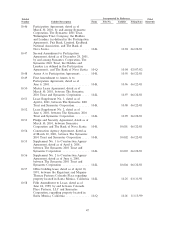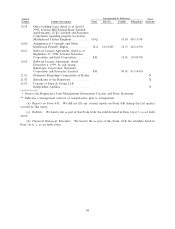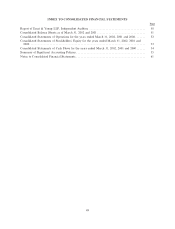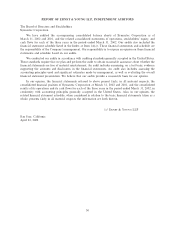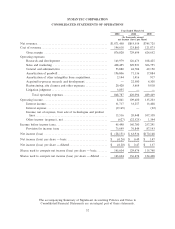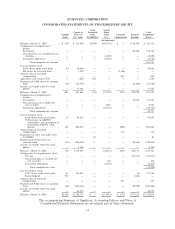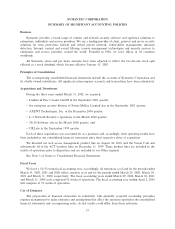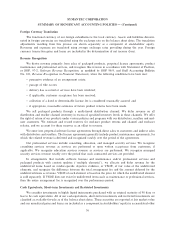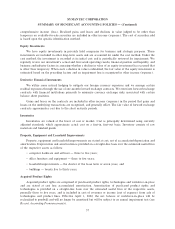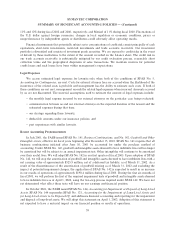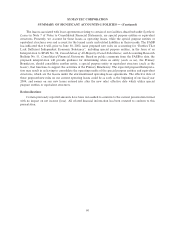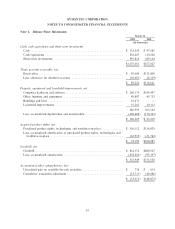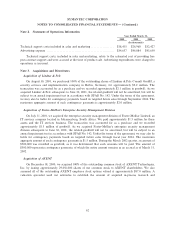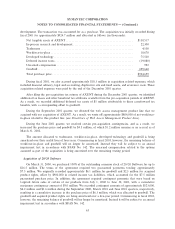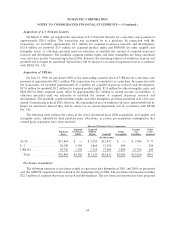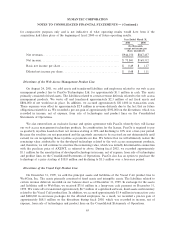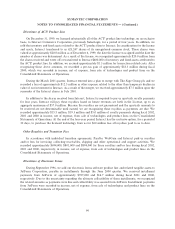Symantec 2002 Annual Report Download - page 79
Download and view the complete annual report
Please find page 79 of the 2002 Symantec annual report below. You can navigate through the pages in the report by either clicking on the pages listed below, or by using the keyword search tool below to find specific information within the annual report.SYMANTEC CORPORATION
SUMMARY OF SIGNIFICANT ACCOUNTING POLICIES Ì (Continued)
comprehensive income (loss). Realized gains and losses and declines in value judged to be other than
temporary on available-for-sale securities are included in other income (expense). The cost of securities sold
is based upon the speciÑc identiÑcation method.
Equity Investments
We have equity investments in privately held companies for business and strategic purposes. These
investments are included in other long-term assets and are accounted for under the cost method. Under the
cost method, the investment is recorded at its initial cost and is periodically reviewed for impairment. We
regularly review our investment's actual and forecasted operating results, Ñnancial position and liquidity, and
business and industry factors in assessing whether a decline in value of an equity investment has occurred that
is other than temporary. When such a decline in value is identiÑed, the fair value of the equity investment is
estimated based on the preceding factors and an impairment loss is recognized in other income (expense).
Derivative Financial Instruments
We utilize some natural hedging to mitigate our foreign currency exposures and we manage certain
residual exposures through the use of one-month forward exchange contracts. We enter into forward exchange
contracts with Ñnancial institutions primarily to minimize currency exchange risks associated with certain
balance sheet positions.
Gains and losses on the contracts are included in other income (expense) in the period that gains and
losses on the underlying transactions are recognized, and generally oÅset. The fair value of forward exchange
contracts approximates cost due to the short maturity periods.
Inventories
Inventories are valued at the lower of cost or market. Cost is principally determined using currently
adjusted standards, which approximate actual cost on a Ñrst-in, Ñrst-out basis. Inventory consists of raw
materials and Ñnished goods.
Property, Equipment and Leasehold Improvements
Property, equipment and leasehold improvements are stated at cost, net of accumulated depreciation and
amortization. Depreciation and amortization is provided on a straight-line basis over the estimated useful lives
of the respective assets as follows:
‚ computer hardware and software Ì three to Ñve years;
‚ oÇce furniture and equipment Ì three to Ñve years;
‚ leasehold improvements Ì the shorter of the lease term or seven years; and
‚ buildings Ì twenty Ñve to thirty years.
Acquired Product Rights
Acquired product rights are comprised of purchased product rights, technologies and workforce-in-place
and are stated at cost less accumulated amortization. Amortization of purchased product rights and
technologies is provided on a straight-line basis over the estimated useful lives of the respective assets,
generally three to Ñve years, and is included in cost of revenues or income (net of expense) from sale of
technologies and product lines. EÅective April 1, 2002, the net balance of workforce-in-place will be
reclassiÑed to goodwill and will no longer be amortized but will be subject to an annual impairment test (see
Recent Accounting Pronouncements).
57


